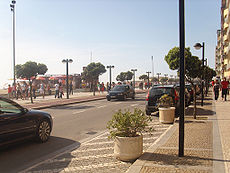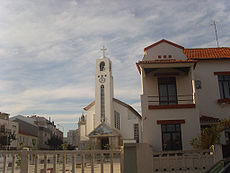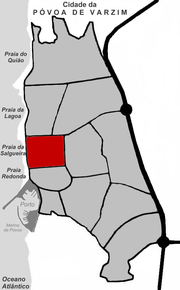
Bairro Norte
Encyclopedia


Portugal
Portugal , officially the Portuguese Republic is a country situated in southwestern Europe on the Iberian Peninsula. Portugal is the westernmost country of Europe, and is bordered by the Atlantic Ocean to the West and South and by Spain to the North and East. The Atlantic archipelagos of the...
city of Póvoa de Varzim
Póvoa de Varzim
Póvoa de Varzim is a Portuguese city in the Norte Region and sub-region of Greater Porto, with a 2011 estimated population of 63,364. According to the 2001 census, there were 63,470 inhabitants with 42,396 living in the city proper. The urban area expanded, southwards, to Vila do Conde, and there...
. it is the most densely populated district of the city, it is also a beach resort. In the 19th century it was known as Bairro de S. José.
History
The urbanization of Bairro Norte started when, King John VIJohn VI of Portugal
John VI John VI John VI (full name: João Maria José Francisco Xavier de Paula Luís António Domingos Rafael; (13 May 1767 – 10 March 1826) was King of the United Kingdom of Portugal, Brazil and the Algarves (later changed to just King of Portugal and the Algarves, after Brazil was recognized...
by the Royal Provision of November 14, 1825, confirmed the possession of the beaches north of the seaport wall to the fishermen of Póvoa . A priest called for a portion of the beach north of the seaport wall to the city hall in order to build a chapel dedicated to Saint Joseph
Saint Joseph
Saint Joseph is a figure in the Gospels, the husband of the Virgin Mary and the earthly father of Jesus Christ ....
. City Hall authorized the idea on September 16, 1837.
In the 19th century was already a bustling fishing neighborhood, but it was already developing as a beach district. This development led to gentrification processes in the typical fisher streets of Bairro Norte such as Ramalhão and Norte streets during most of the 20th century.
Geography

Agro-Velho
Agro-Velho or Nova Póvoa is a beach resort district of the Portuguese city of Póvoa de Varzim and located around Lagoa Cove...
, Barreiros
Barreiros, Póvoa de Varzim
Barreiros is a neighbourhood of the Portuguese city of Póvoa de Varzim. it is considered an inland expansion of Bairro Norte.Barreiros appears, for the first time, in a document of 1577. During that time, the place was an extensive territory of woodland and farm fields.Currently, it is a...
, and Parque da Cidade
Parque da Cidade
230px|thumb|View from the city park.Parque da Cidade is a neighourhood of the Portuguese city of Póvoa de Varzim. It literally means City Park, as it is were the city's park is located and occupies most of the land area. This part of the city is set in four distinct parishes: Amorim, Aver-o-Mar,...
.
The new district center, with residential blocks and street shops, is being built after the displacement of a rope-making factory.

